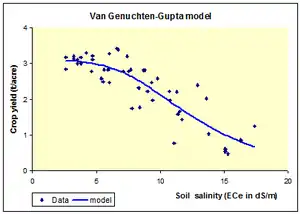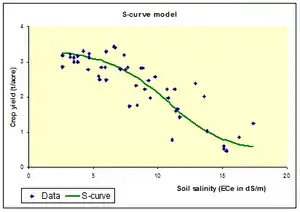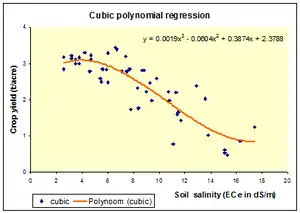Van Genuchten–Gupta model
The Van Genuchten–Gupta model is an inverted S-curve applicable to crop yield and soil salinity relations.[1] It is named after Martinus Theodore van Genuchten and Satyandra K. Gupta's work from the 1990s.

Equation
The mathematical expression is:
where Y is the yield, Ym is the maximum yield of the model, C is salt concentration of the soil, C50 is the C value at 50% yield, and P is an exponent to be found by optimization and maximizing the model's goodness of fit to the data.
In the figure: Ym = 3.1, C50 = 12.4, P = 3.75
Alternative one

As an alternative, the logistic S-function can be used.
The mathematical expression is:
where:
with Y being the yield, Yn the minimum Y, Ym the maximum Y, X the salt concentration of the soil, while A, B and C are constants to be determined by optimization and maximizing the model's goodness of fit to the data.
If the minimum Yn=0 then the expression can be simplified to:
In the figure: Ym = 3.43, Yn = 0.47, A = 0.112, B = -3.16, C = 1.42.
Alternative two

The third degree or cubic regression also offers a useful alternative.
The equation reads:
with Y the yield, X the salt concentration of the soil, while A, B, C and D are constants to be determined by the regression.
In the figure: A = 0.0017, B = 0.0604, C=0.3874, D = 2.3788. These values were calculated with Microsoft Excel
The curvature is more pronounced than in the other models.
See also
References
- M. Th. van Genuchten and S.K. Gupta, 1993. USDA-ARS, U.S. Salinity Laboratory 4500 Glenwood Drive, Riverside, California, USA, 92501. A reassessment of the Crop Tolerance Response Function. Journal of the Indian Society of Soil Science, Vol. 41, No. 4, pp 730–737.